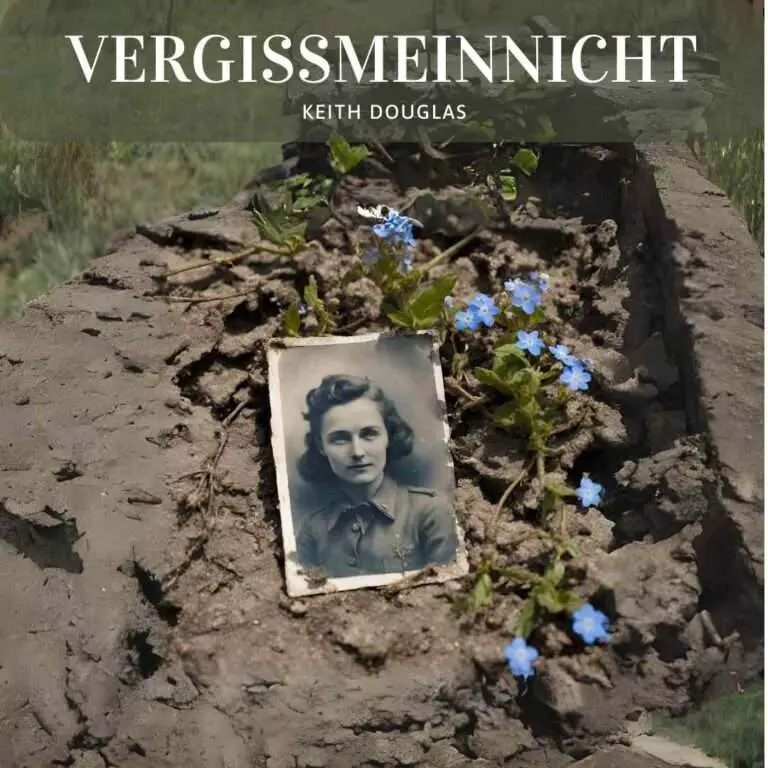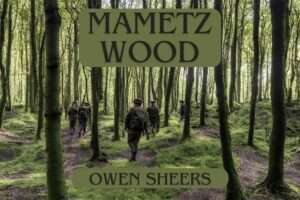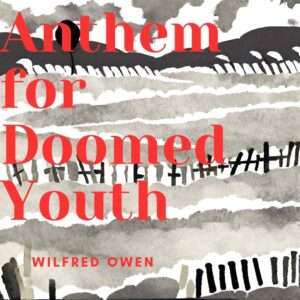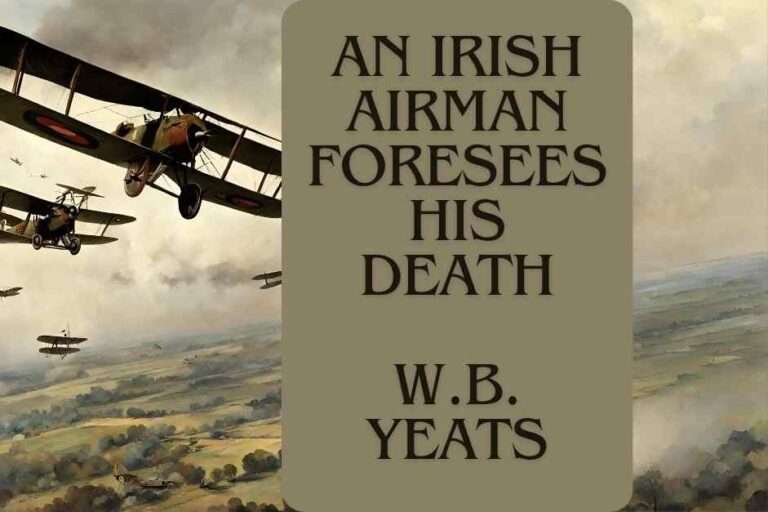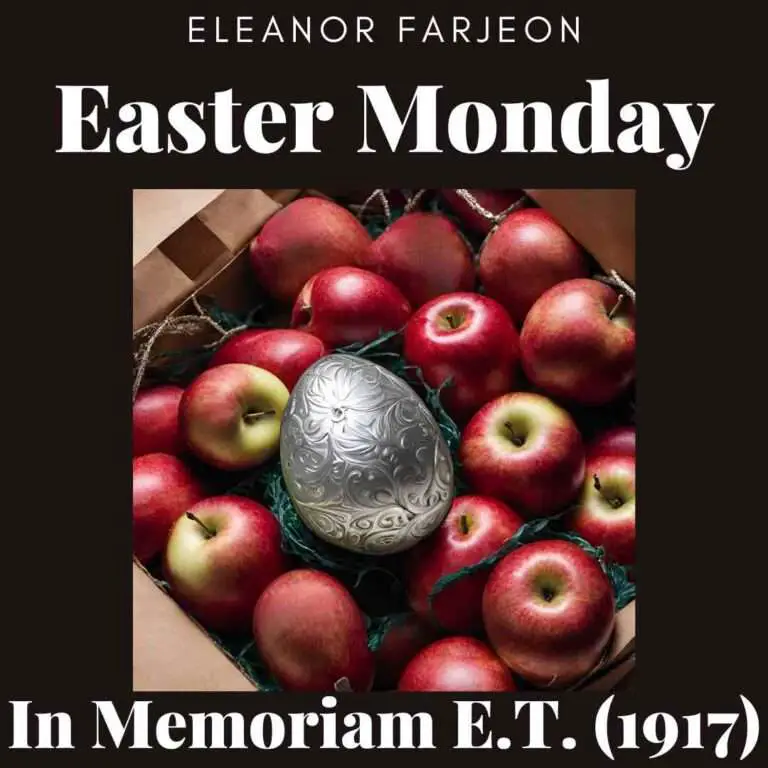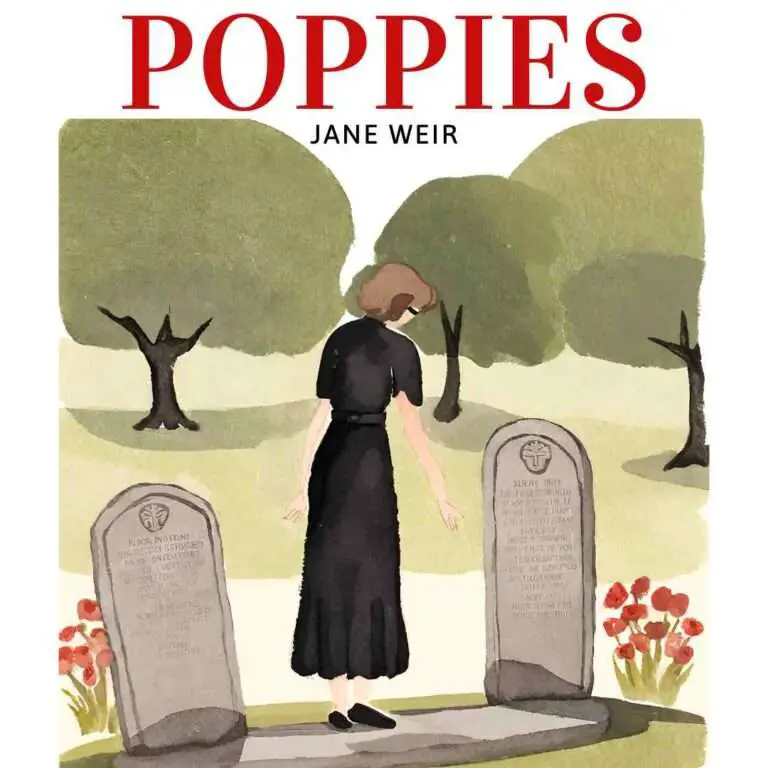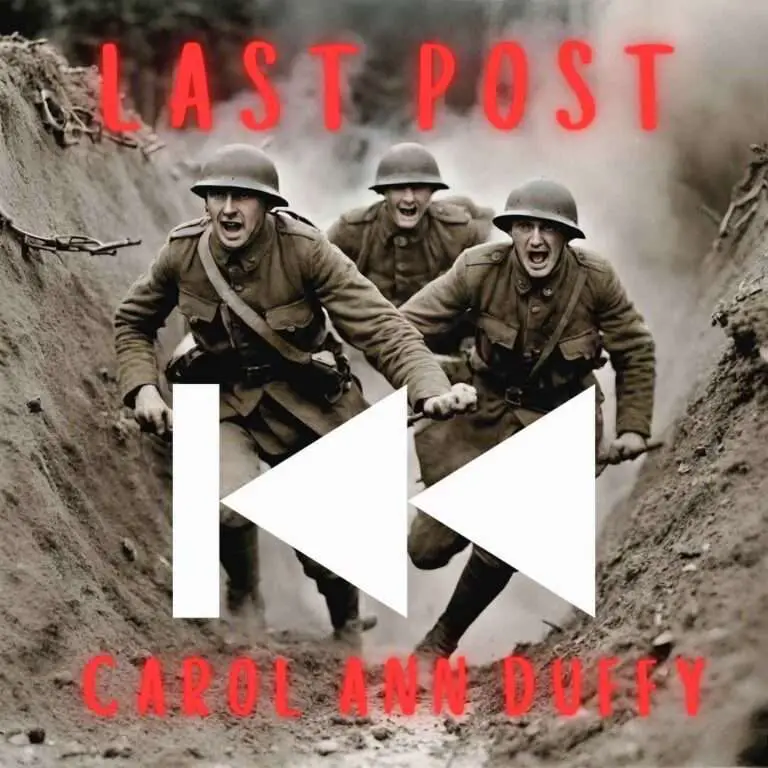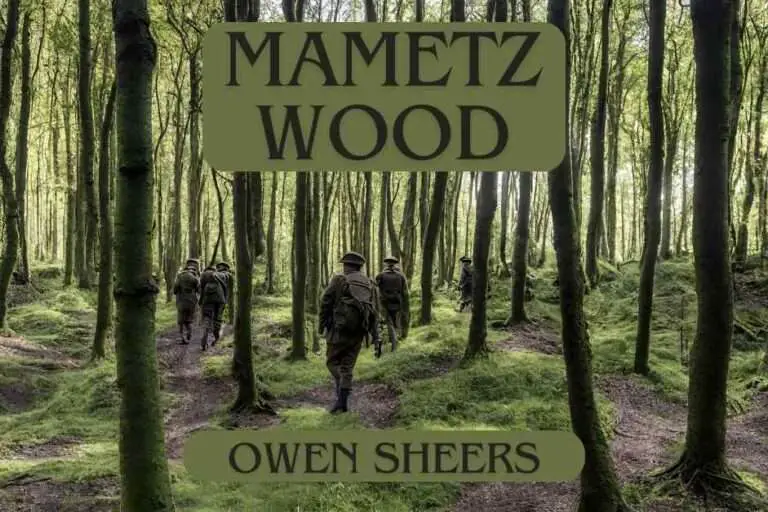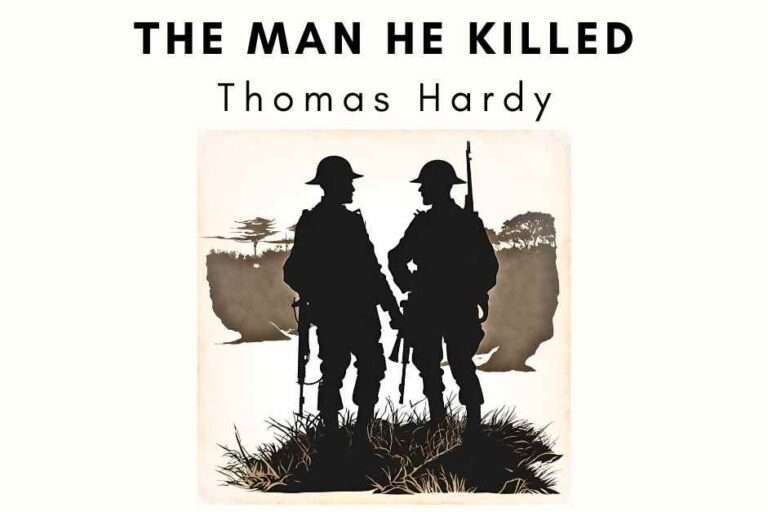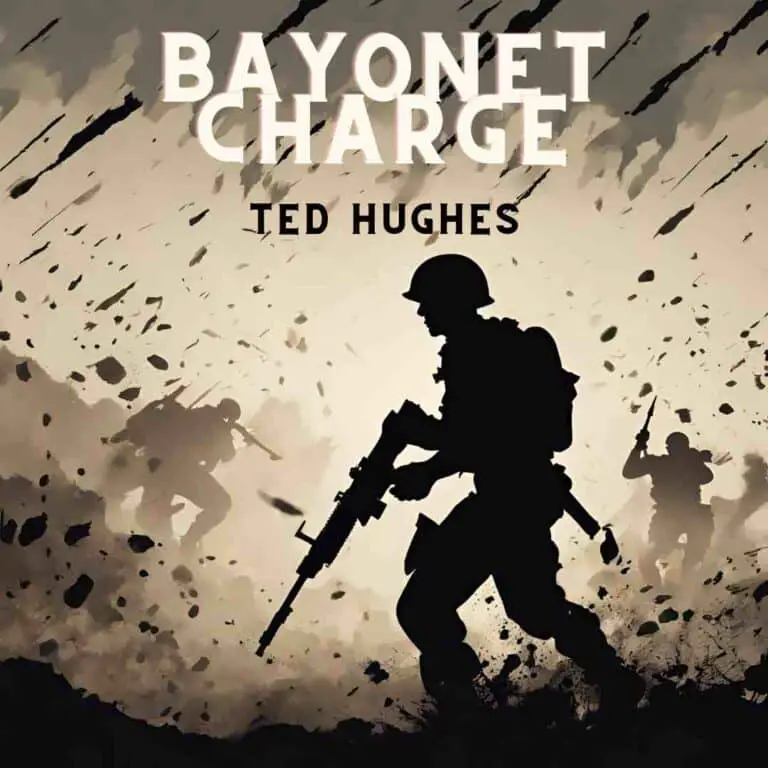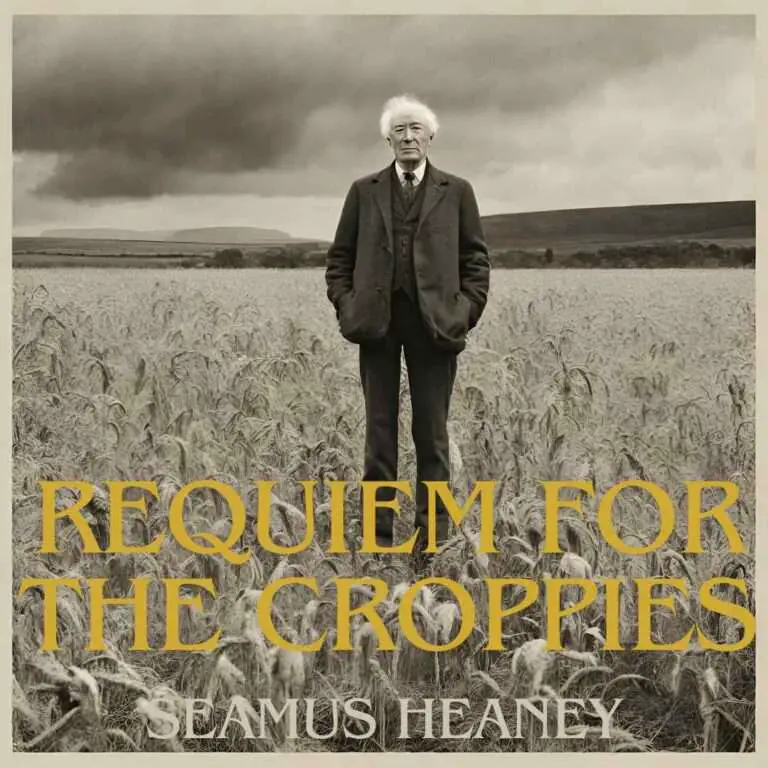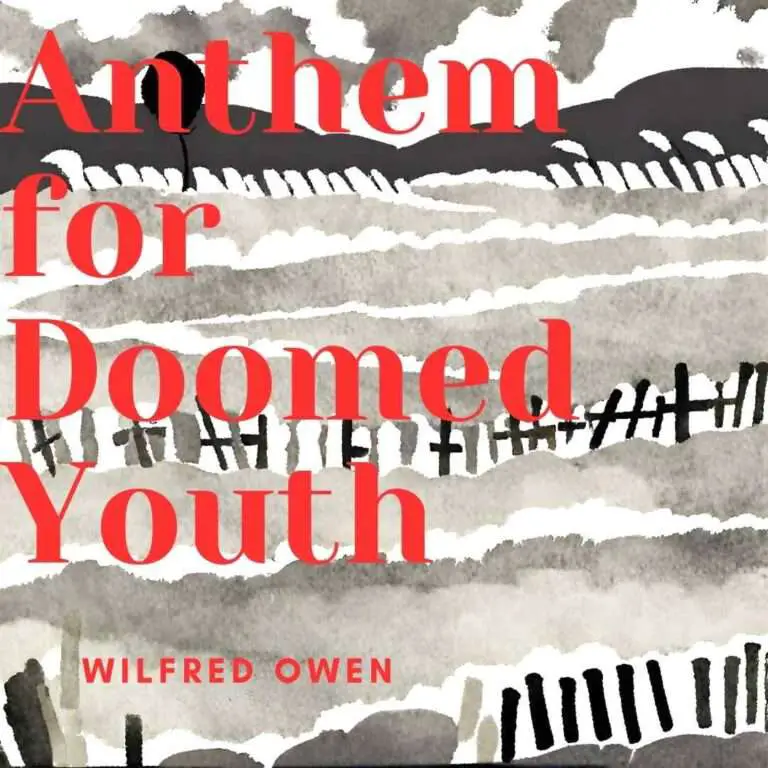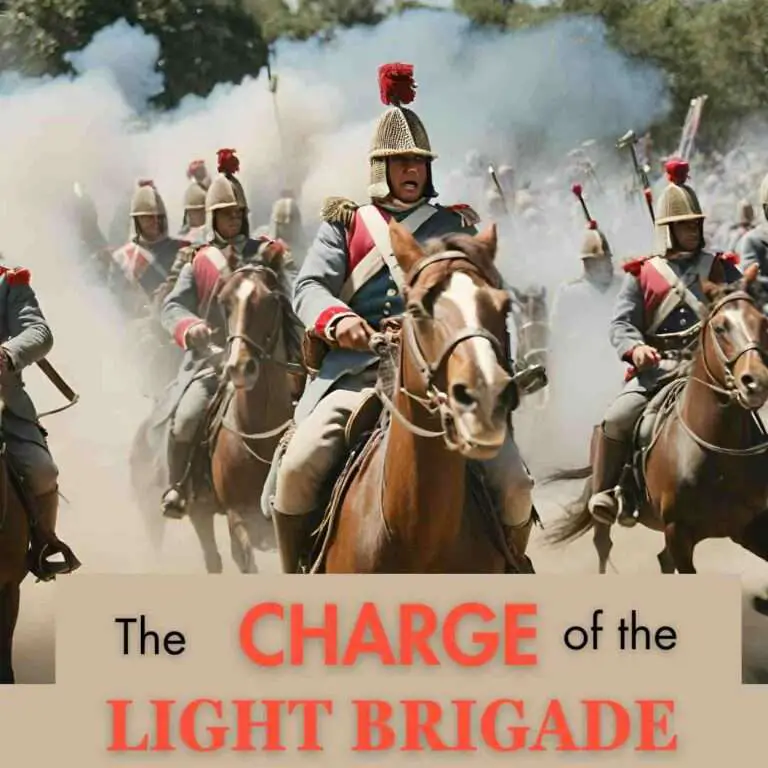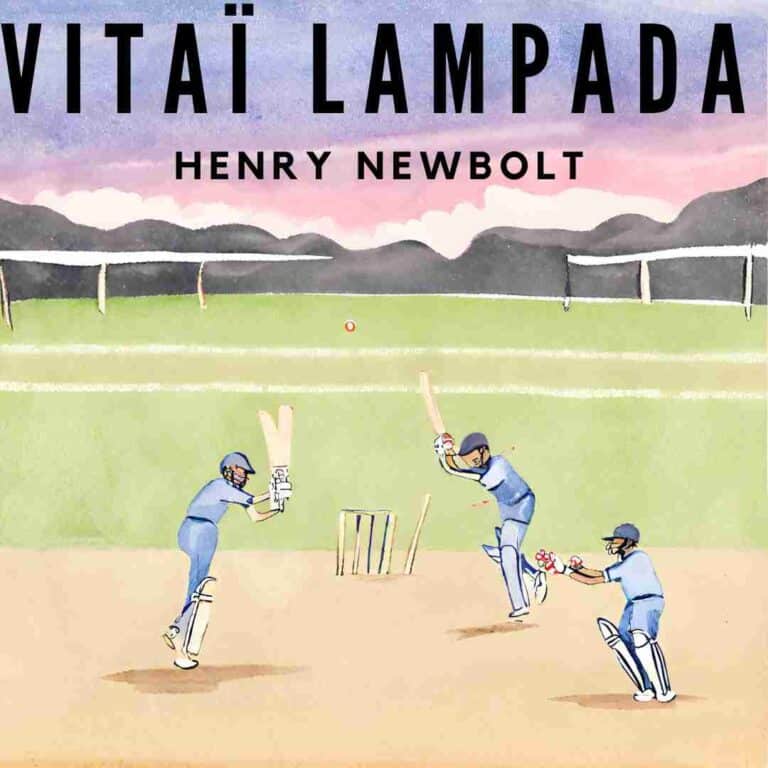Vergissmeinnicht by Keith Douglas explores the grim juxtaposition of love and war amid WWII. Douglas depicts the grim aftermath of battle through the discovery of a dead German soldier’s personal effects which include a photograph of his love, ‘Steffi’. Read on for analysis, questions and connections to other conflict poems.
This study guide is written for students and teachers of English Literature, particularly those studying CCEA’s GCSE English Literature Conflict Anthology and OCR’s GCSE English Literature Conflict Anthology. For more study guides from this anthology, check out the Conflict page, or the list of poems in the series at the bottom of this guide.
Vergissmeinnicht
Three weeks gone and the combatants gone
returning over the nightmare ground
we found the place again, and found
the soldier sprawling in the sun.
The frowning barrel of his gun
overshadowing. As we came on
that day, he hit my tank with one
like the entry of a demon.
Look. Here in the gunpit spoil
the dishonoured picture of his girl
who has put: Steffi. Vergissmeinnicht.
in a copybook gothic script.
We see him almost with content,
abased, and seeming to have paid
and mocked at by his own equipment
that’s hard and good when he’s decayed.
But she would weep to see today
how on his skin the swart flies move;
the dust upon the paper eye
and the burst stomach like a cave.
For here the lover and killer are mingled
who had one body and one heart.
And death who had the soldier singled
has done the lover mortal hurt.
What is 'Vergissmeinnicht' about?
Summary of verse 1
The first verse describes British soldiers walking back across land they had fought on three weeks before. As they rediscover this land, they find the German soldier who had attacked their tank ‘sprawled’ in the sun. At this stage of the poem, it is not yet revealed that this German soldier is dead.
Summary of verse 2
In verse two, the speaker remembers the encounter three weeks before, when this particular German soldier had shot a bullet through their tank, which had felt like a hellish and demonic attack.
Summary of verse 3
The third verse reveals an unexpected detail: in the gunpit’s debris, they find a picture of the soldier’s girlfriend, with “Steffi” and “Vergissmeinnicht” written by her. ‘Vergissmeinnicht’ is German for ‘forget me not’, reminding the readers of family and loved ones impacted by the war.
Summary of verse 4
The fourth verse describes the dead soldier and the equipment by his side. The irony is that the soldier is rotting and decaying, but his rifle and equipment remain in good condition, seeming to mock their late owner.
Summary of verse 5
In the fifth verse, the speaker’s thoughts shift to the soldier’s lover, whom he imagines grieving at the sight of his deteriorating body, with flies buzzing around him and his stomach violently split open.
Summary of verse 6
The final verse reflects on the intertwined identities of the German soldier: both lover and fighter, emphasising the irreversible harm inflicted by death in combat.
Context of 'Vergissmeinnicht'
Keith Douglas' life, education and career
Keith Douglas (1920-1944) was a British poet and soldier, known today as one of the most powerful poets of WWII.
Born on January 24, 1920, in Tunbridge Wells, Kent, Douglas’ early life was plagued by financial troubles, his mother’s ill health and his father’s absence and later, remarriage.
Despite the family’s financial struggles, Douglas was educated Edgeborough School, a prep school in Guildford, and later, at Merton College, Oxford University. He demonstrated an early interest in literature and poetry, publishing his first collection of poems, “The Yellow Dove,” in 1941.
However, his literary pursuits were interrupted by the outbreak of World War II, and he enlisted in the British Army in 1940. Serving as a tank commander in North Africa, Douglas experienced firsthand the brutality and devastation of war, which deeply influenced his poetry. Despite facing danger and witnessing the horrors of battle, Douglas continued to write and publish poetry, including his most famous work, “Vergissmeinnicht.”
Tragically, Keith Douglas was killed in action on June 9, 1944, during the Allied invasion of Normandy, and is buried in Tilly-sur-Seulles War Cemetery in Normandy.
Context of 'Vergissmeinnicht'
Vergissmeinnicht was written during World War II (1939 to 1945). Douglas enlisted in 1939 and began his training in England in July 1940.
Douglas was involved in the North Africa Campaign, which took place from 1940 to 1943. This campaign saw intense fighting between Allied forces (including British, American, and Commonwealth troops) and Axis forces (primarily German and Italian troops) in the deserts of North Africa, particularly in Egypt and Libya. Douglas was posted to the Middle East in July 1941, but did not see any action until he sent himself to the front line in October 1941.
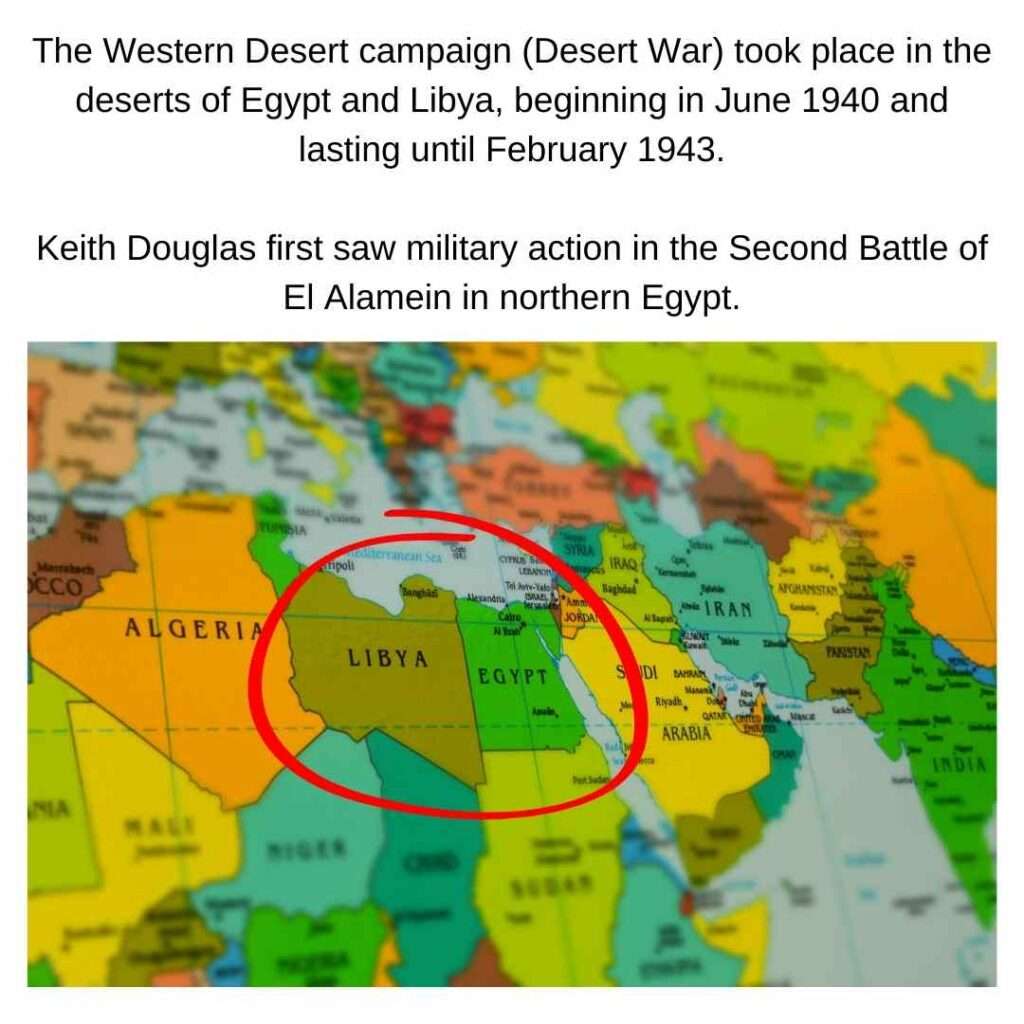
Douglas served as a tank commander during the war, operating in armoured vehicles equipped with guns and cannons. Vergissmeinnicht reflects on his firsthand experiences of combat and the realities of tank warfare in the harsh desert environment.
It is important to recognise that “Vergissmeinnicht” is not just a fictional narrative but draws heavily from Douglas’s own experiences and observations on the battlefield. Understanding this personal connection adds depth and authenticity to the poem’s portrayal of war.
Although the poem does not directly reference it, the timing of its composition is significant. Douglas was killed in action on June 9, 1944, during the Allied invasion of Normandy (D-Day), just days after the events described in Vergissmeinnicht. This adds poignancy to the poem as one of Douglas’s final reflections on war before his death.
Line-by-line analysis
Stanza 1
Three weeks gone and the combatants gone
- The repetition of ‘gone’ creates a sense of closure and finality, reinforcing the idea of the passage of time.
- The trochaic rhythm of this line, with the emphasis on “gone,” reflects the steady march of time, contributing to the poem’s sense of inevitability.
- The use ‘combatants’ evokes the conflict and violence of war, setting the tone for the rest of the poem.
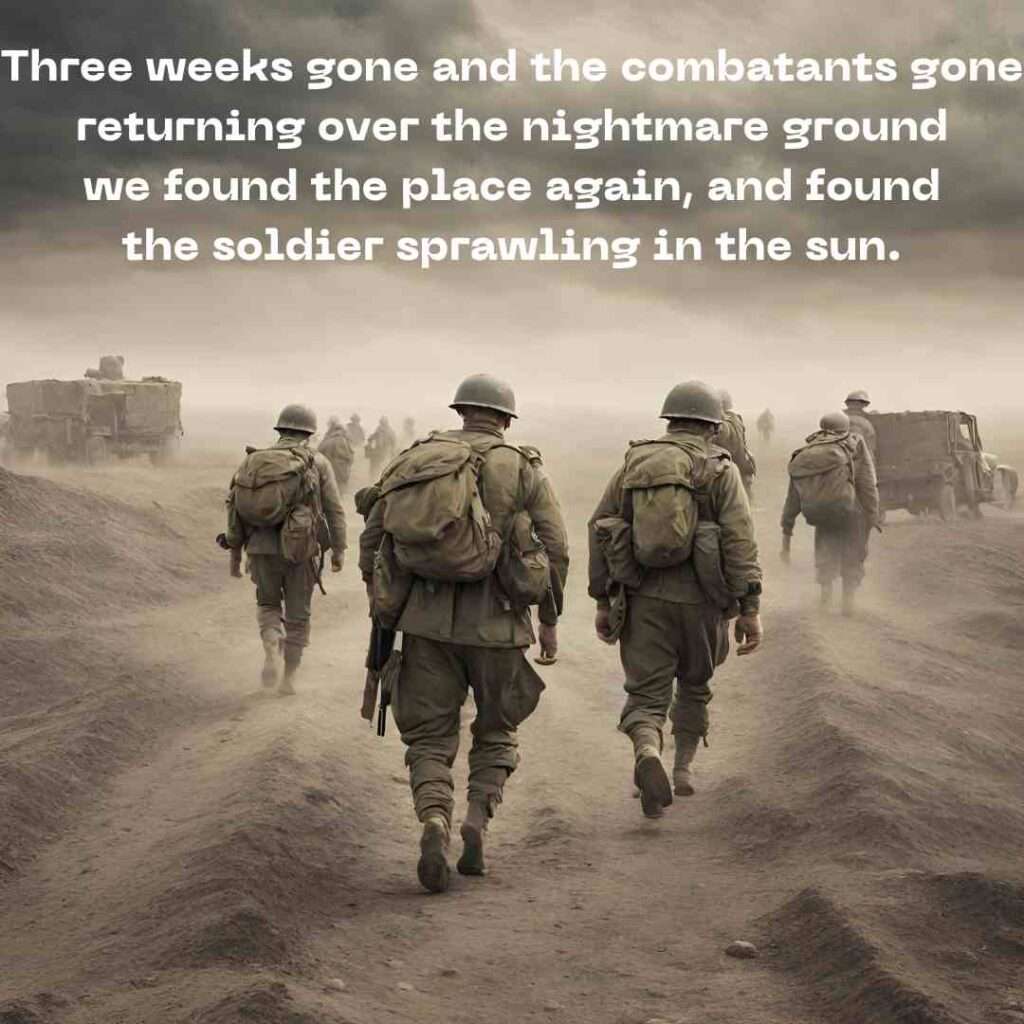
returning over the nightmare ground
- The adjective ‘nightmare’ conjures images of a devastated battlefield, emphasising the horror and trauma of war.
- In returning to the scene of a previous encounter, the speaker is reliving the experience in real life. In contrast, many soldiers suffered PTSD, reliving the horrors of war in their nightmares, for example in Wilfred Owen‘s Dulce Et Decorum Est. In Vergissmeinnicht, the ‘nightmare ground’ is not a nightmare, but a literally relived experience.
- There is enjambment in this line, and indeed the whole stanza, which continues the narrative from the previous one, maintaining the poem’s cohesive structure and sense of progression.
we found the place again, and found
- The repetition of ‘found’ emphasises the significance of the location and the act of rediscovery, suggesting a sense of intentionality, that they sought out this location as somewhere of importance.
- The repetition of ‘found’ to rhyme with ‘ground’ is one of the complete rhymes of the poem. The ABBC rhyme scheme of this verse means that the full rhyme is enclosed within an unrhymed frame, and the effect is as unsettling as the content of the verse: finding a dead and decaying enemy soldier.
- The use of commas creates a caesura (pause), drawing attention to the repetition and allowing the reader to reflect on the significance of finding the place again.
the soldier sprawling in the sun.
- The image of the soldier ‘sprawling in the sun’ seems, on the surface, relaxing. This image juxtaposes the brutality of war with the tranquillity of nature, highlighting the stark contrast between life and death.
- The imagery is heightened by the sibilance of ‘soldier sprawling in the sun’, adding a hissing effect, almost to spit out the disgust of the speaker in seeing his dead attacker. Or, the sibilance could be used to ironically emphasise the relaxed posture of the soldier; ironic as he is dead, not relaxing.
- The full stop at the end of the line closes off this stanza, creating a sense of finality, marking the soldier’s death as an irrevocable fact.
Stanza 2
The frowning barrel of his gun
- The personification of the gun’s barrel as ‘frowning’ gives it a sense of menace and hostility, reinforcing the theme of violence and death.
- The long vowel sound in “frowning” and “barrel” creates a sense of unease, adding to the ominous atmosphere.
- In the next line, the frowning gun is casting a shadow, again adding to the menacing tone of the verse and the menacing impact of the weapon.
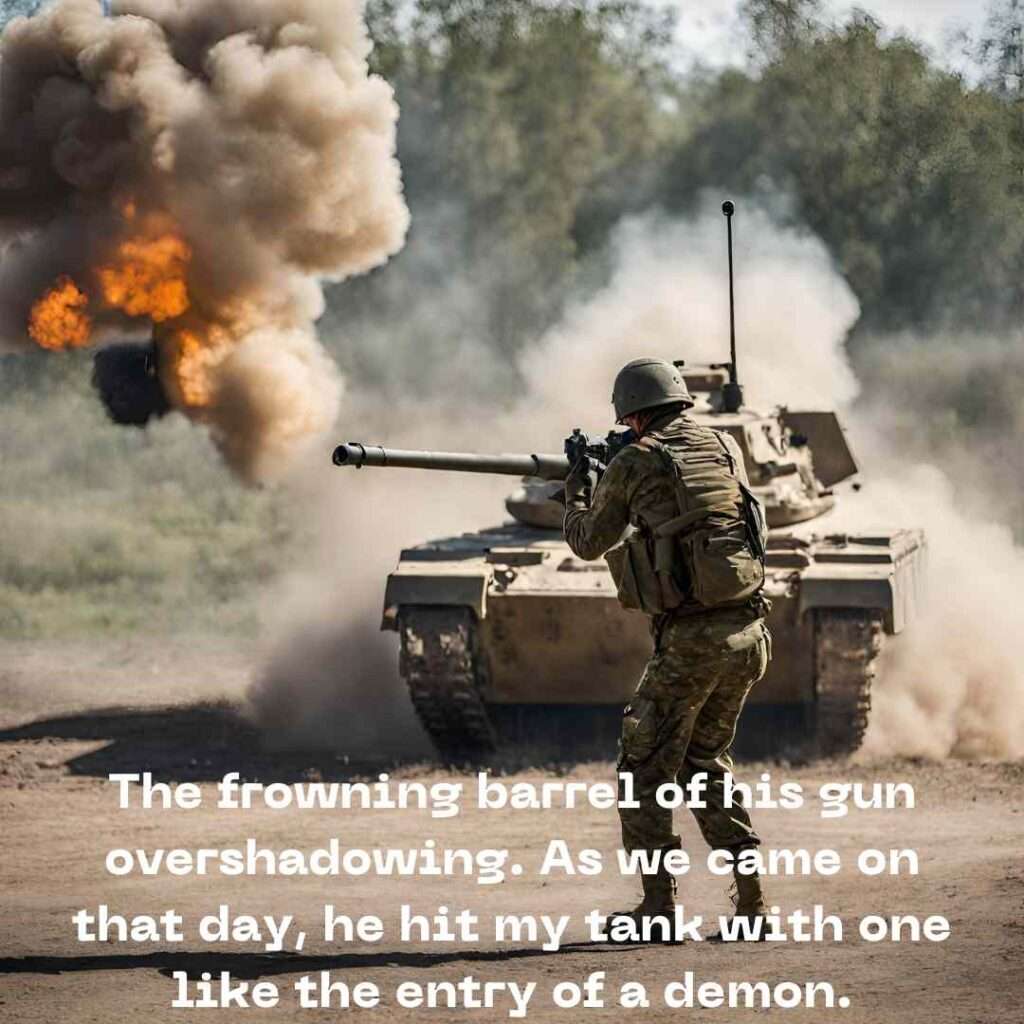
overshadowing. As we came on
- The verb ‘overshadowing’ suggests a sense of dominance and control, further emphasising the theme of conflict. On a more practical note, the shadows suggest the strong sun and heat of the desert, and therefore the decay of the body, adding to the gruesome images that come later in the poem.
- The line is fractured by the full stop. The caesura interrupts the flow of the line, before the enjambment at the end of the line into the next. The continuation of the sentence onto the next line with “As we came on” creates a sense of momentum, propelling the narrative forward, away from the opening, isolated ‘Overshadowing’.
that day, he hit my tank with one
- The comma after ‘day’ creates a caesura (pause), allowing the story to unfold.
- The image of the soldier hitting the speaker’s tank with his gun reinforces the sense of conflict and danger, adding to the scene’s tension.
- The very recent memory of the attack creates a sense of grim victory: these soldiers have lived on to fight another day, and they are ‘content’ (mentioned later) to see their attacker dead. As the reader, we must be the ones to interpret our feelings towards this, as the speaker does not lead us emotively, but rather with a very factual tone.
like the entry of a demon.
- The simile here hits hard: the attack three weeks before is one that the speaker has not forgotten. Indeed, it is burned into his memory in a hellish and lasting manner. So much so, that three weeks later the speaker scours the area for the place of the attack and finds the very man who attacked him.
- The use of ‘demon’ for the opposition leads the reader to a sense that the German army is the evil one in this conflict.
Stanza 3
Look. Here in the gunpit spoil
- The use of the imperative (command verb) ‘Look’ in a one-word sentence commands the reader’s attention, drawing them into the scene and encouraging them to engage with the imagery.
- The phrase ‘gunpit spoil’ refers to the hole a soldier would dig to rest his gun in during combat. However, ‘the spoils’ is a phrase used to refer to the loot or bounty found, and may give a clue as to why the British soldiers have returned to this exact place: they are perhaps detouring to collect the spoils, ie the abandoned weapons.
- There is again a sense of victory in the tone of the speaker as he looks down at the dead body.
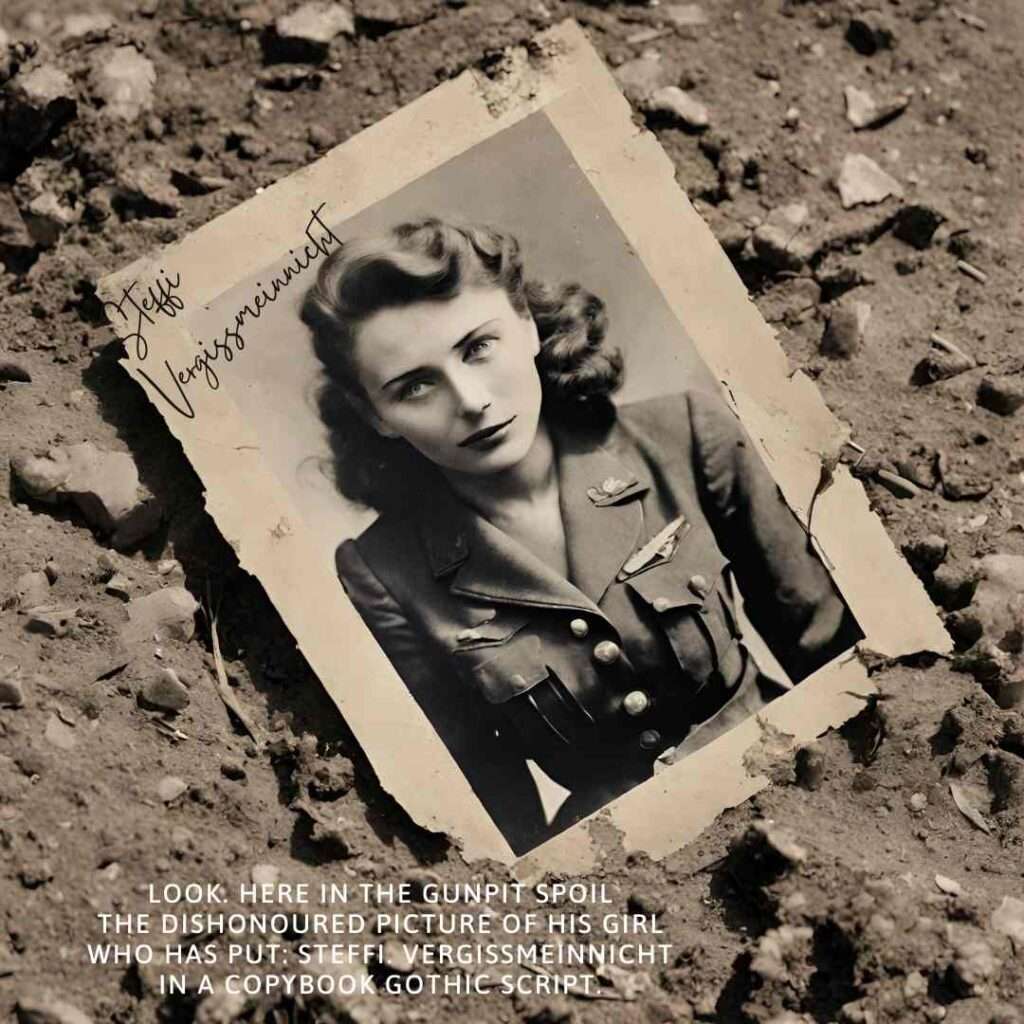
the dishonoured picture of his girl
- The adjective ‘dishonoured’ offers two interpretations: firstly, of the dirtied state of the picture in the dust and dirt of the ground. Secondly, it implies a sense of her own dishonourable state, in being the girlfriend of an enemy soldier. Again, the lines of the ‘good’ versus the ‘bad’ in this conflict are drawn by the speaker. And it is interesting to not how women in war were often ‘dishonoured’ in the way they were treated, or mistreated, by conquering forces.
- The ‘picture of his girl’ symbolises the soldier’s personal life, reminding the reader of the human side of the conflict. The soldier is later described in such a dehumanising way that the reader needs the picture to remind them that he was a real person with a story.
who has put: Steffi. Vergissmeinnicht
- The mention of ‘Steffi’ emphasises the theme of love amidst the brutality of war.
- The use of the soldier’s girlfriend’s name and the word ‘Vergissmeinnicht’ (German for ‘forget-me-not’) creates a whole story for the reader of the soldier’s identity and personal life.
- The colon and full stop in the middle of the line create pauses, adding a tone of disgust in the speaker’s voice.
in a copybook gothic script.
- The phrase ‘copybook gothic script’ suggests the innocence of romance, love letters and photographs, contrasting with the grim reality of war and death described in the poem.
Stanza 4
We see him almost with content,
- The phrase ‘almost with content’ suggests the British soldier, the speaker, is, at best, emotionless at the sight of the dead German soldier. This attitude highlights the soldier’s cold and desensitised state.
- The adverb ‘almost’ introduces a sense of ambiguity. Can the speaker really be pleased to see the German dead? Or is he too far into a traumatised state after so much bloodshed that he cannot process his feelings? The adverb leaves room for interpretation, inviting the reader to question the soldier’s real feelings.
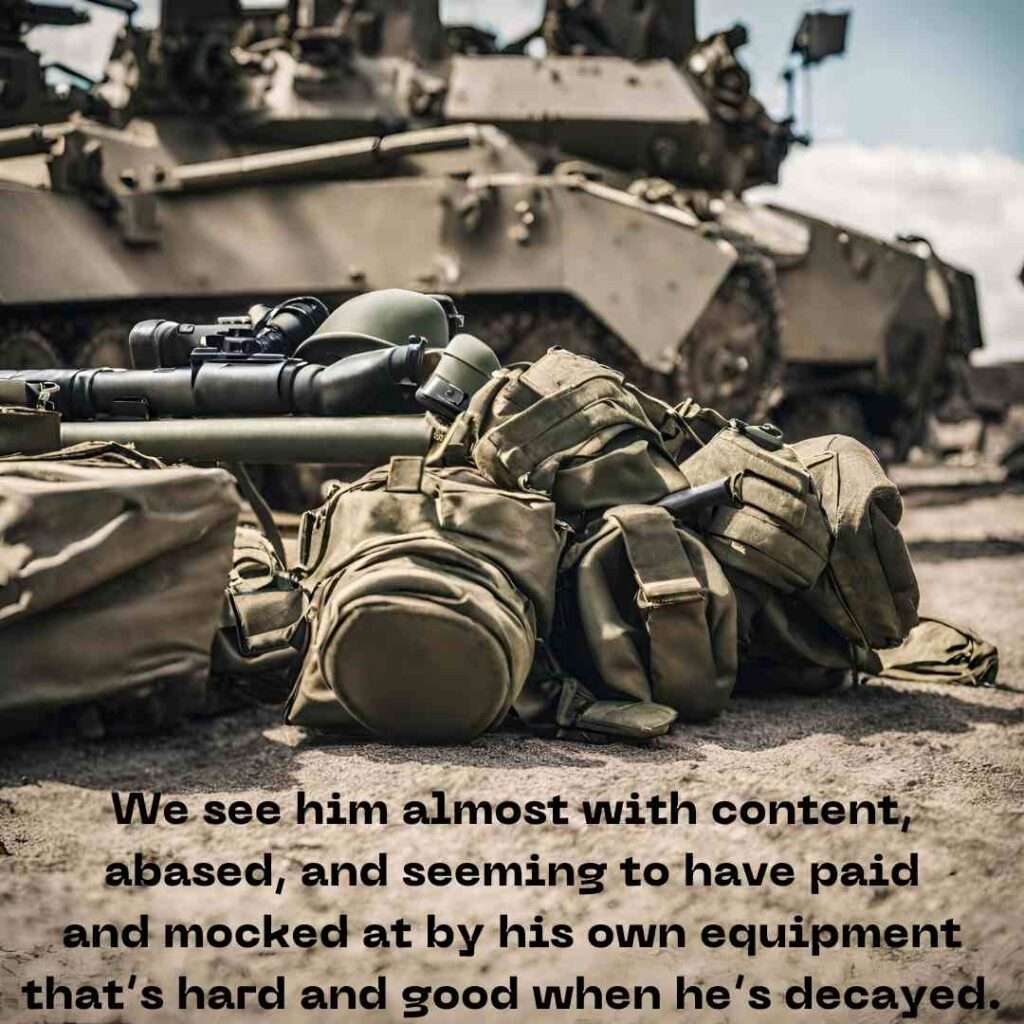
abased, and seeming to have paid
- The adjective ‘abased’ shows the speaker’s sense of superiority and victory in being alive, dehumanising the soldier who lies dead at his feet.
- The sibilant repetition of the ‘s’ sound in ‘abased’ and ‘seeming’ creates a hissing, mocking tone.
and mocked at by his own equipment
- The personification of the tools of war, ‘mocked at by his own equipment’ is ironic, given the fact that the equipment is only effective when animated by a human, but that human lies dead.
- The perspective here is important to note: the dead German is being mocked only in the eyes of the speaker who is a British soldier. The critical tone reveals more about the speaker than the dead soldier. Despite the dehumanising effect of lying sprawled dead on the ground, it is the speaker who is dehumanised in his cold, hard tone of voice.
that's hard and good when he's decayed.
- The phrase ‘hard and good when he’s decayed’ highlights the contrast between the soldier’s former vitality and his current state of decay.
- There is a tongue-in-cheek tone here, in referring to the soldier’s ‘equipment’ which is ‘hard’ (if you know what I mean … wink wink). The German soldier’s own ‘equipment’ will never be ‘good and hard’ again, while the tools of war, the weaponry, are as ‘good and hard’ as ever. Douglas uses the innuendo here to perhaps highlight the impotence of the conflict: there are no winners, only men destroyed and women grieving.
Stanza 5
But she would weep to see today
- The image of Steffi weeping sits at odds with reality: the only person who might indeed weep for the dead soldier is the girl in the picture who will never see his dead body.
- The use of ‘today’ adds irony, as it is only the British soldiers who see him ‘today’, and they do not weep, but rather feel a sense of satisfaction in what they see.
how on his skin the swart flies move;
- The adjective ‘swart’ is archaic, suggesting the dark colour of the flies, and is emphasised through the use of sibilance: ‘his skin the swart flies move’.
- The image (of flies over a dead body) is of decay and decomposition, showing the brutal reality of death on the battlefield.
the dust upon the paper eye
- The image of ‘dust upon the paper eye’ reminds the reader of the setting of the poem: the dust and heat of the Western Desert Campaign, helping to set the scene in the reader’s mind. The delicate skin around the soldier’s eye has been dried by the heat to ‘paper’, a metaphor which makes the soldier seem fragile and delicate in death and decay, regardless of how brave and full of life he has been before.
- The ‘paper eye’ symbolises the soldier’s humanity, yet the reference to only his eye and his stomach (in the next line) is dehumanising: to reduce the man to two parts removes from him all his individuality and life. In literature, this is called synecdoche.
and the burst stomach like a cave.
- The simile of his stomach as a cave is brutally vivid: his abdomen is hollowed out and exposed for all to see.
- The verb ‘burst’ is also brutal and reminds the reader of the danger of war.
- The pararhyme of ‘move’ and ‘cave’ i.e. the same consonant sounds with different vowel sounds, creates an eerie effect.
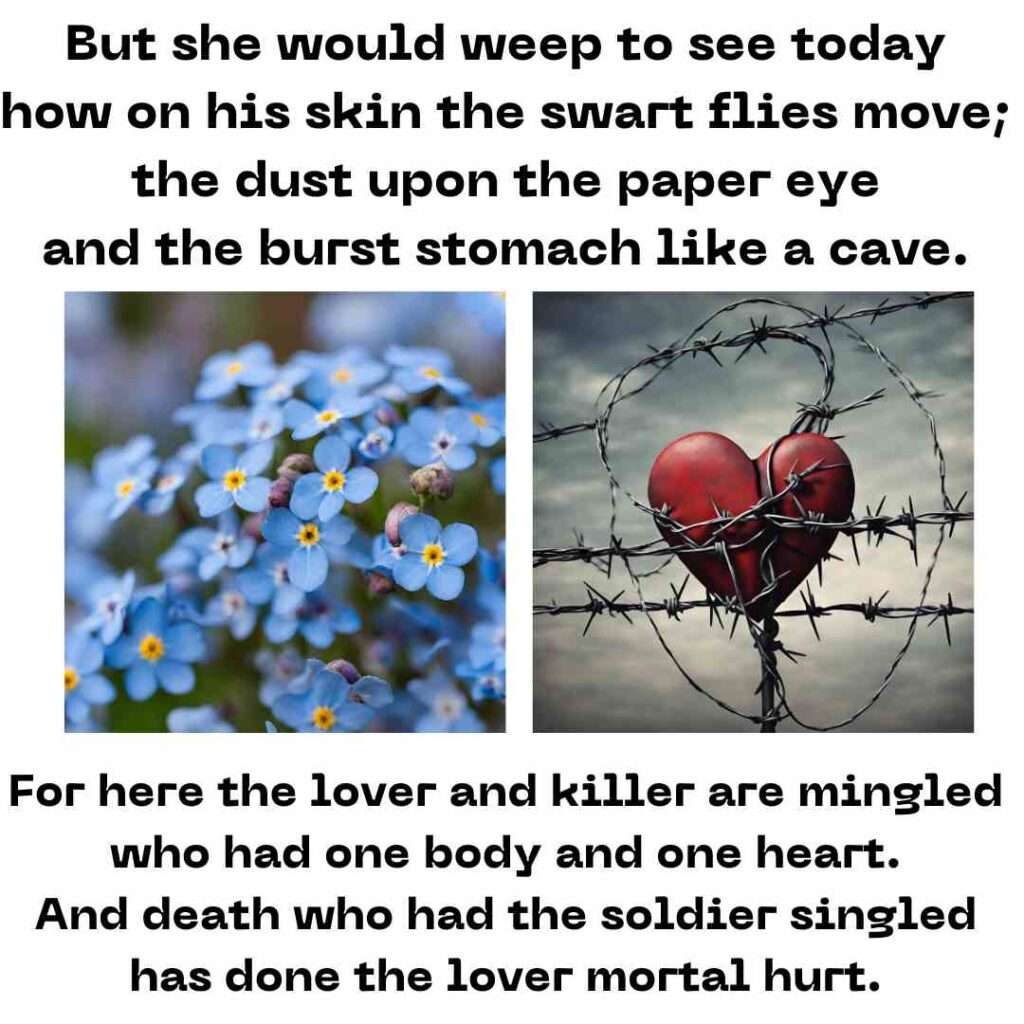
Stanza 6
For here the lover and killer are mingled
- The phrase ‘lover and killer are mingled’ highlights the dual nature of the soldier’s identity: while he may be Steffi’s lover, he has been a killer too, and neither one overrides the impact of the other.
- The juxtaposition of ‘lover and killer’ adds depth to the line, inviting the reader to reflect on the contradiction of the two identities.
- Again, the tone is important to link to the perspective: the speaker calls the German soldier ‘lover and killer’ rather than ‘lover and soldier’, reminding us of the bias in the speaker’s point of view.
who had one body and one heart.
- The image of the soldier having ‘one body and one heart’ suggests a sense of unity in his identity.
- The speaker reveals a chink in his armour in this reluctant acknowledgement that the German soldier is a human being with a personal life.
- The repetition of ‘one’ and the pairing of ‘body’ and ‘heart’ balanced across the conjunction ‘and’ is rhetorically beautiful and emotive. This is the first break in the otherwise steely cold and distant narration.
And death who had the soldier singled
- The personification of death emphasises its role as a merciless and indiscriminate force.
- The verb ‘singled’ suggests that death is in charge, choosing and chasing each man in turn. This perspective is again important to note, suggesting a sense of fate and inevitability in conflict.
- The full rhyme of ‘mingled’ and ‘singled’ in this verse adds completeness and finality, emphasising the role of death in completing things.
has done the lover mortal hurt.
- The phrase ‘done the lover mortal hurt’ takes the reader back to the photograph of Steffi and the loss and grief felt by family and loved ones during war.
- Despite the mortal wound being done to the soldier, it is the lover who is suffering ‘mortal hurt’.
- The use of ‘mortal’ adds a sense of finality, emphasising that none of this can be undone.
Analysis of form and structure
Verse structure
Vergissmeinnicht is made up of six quatrains (four-line verses) creating a very regular structure. Despite the use of enjambment within the verses, each verse ends with a full stop. This gives further importance to the structure of six verses of equal, regular length.
The poem is set amid warfare and battle, and perhaps the regular structure reflects the regularity of army life. Or perhaps in the predictability of each verse, the predictability, or unpredictability of war can thrive.
Rhyme
The rhyme scheme of Vergissmeinnicht is complicated. While there are examples of no rhyme and of full rhymes, there are also partial rhymes, known as pararhyme, where the consonant sounds are the same but the vowel sounds are different. We see this in ‘gone’ and ‘sun’ in verse one, ‘move’ and ‘cave’ in verse 5, and ‘heart’ and ‘hurt’ in verse six.
Overall, the rhyme scheme can be described as irregular.
Rhythm
The rhythm of Vergissmeinnicht is largely regular, with four pairs of syllables per line, known as tetrameter.
The pattern within each pair of syllables is mostly iambic, meaning the stressed syllable comes second. Let’s look at an example:
We see/ him al/most with/ content,/
abased,/ and seem/ing to/ have paid/
and mocked/ at by/ his own/ equip/ment
that’s hard/ and good/ when he’s/ decayed./
Here you can see the syllables in bold are the stressed syllables, and the verse falls into almost perfect iambic tetrameter, except for the extra syllable at the end of line three, a falling syllable. Douglas achieves both the coldness of the speaker’s attitude through the monotony of the rhythm, while also unsettling the reader with the slight variation of the extra syllable in line three.
Other verses in Vergissmeinnicht are not as precisely regular as this one, but on the whole, they follow a similar pattern of iambic tetrameter.
Themes in 'Vergissmeinnicht'
Decay
The imagery of death and decay runs throughout the poem. The speaker describes the decaying body of the German soldier in vivid detail, and the reader may struggle to align the coldness of the descriptions with the humanity of Steffi and the loss of life.
Identity
Through its portrayal of the soldier’s personal belongings and the remnants of his life, the poem explores themes of identity and humanity. It emphasises the individuality of each soldier and the profound loss of human life that occurs in war, challenging readers to confront the human cost of conflict.
Love at war
Amidst the horrors of war, the poem reflects on the enduring power of love and the sense of loss experienced by those left behind. It juxtaposes themes of love and death, showing that emotions and personal connections endure even in the face of tragedy.
Quiz on 'Vergissmeinnicht' by Keith Douglas
‘Vergissmeinnicht’ Quiz
Test your knowledge of the poem 'Vergissmeinnicht' by Keith Douglas.
Question
Your answer:
Correct answer:
Your Answers
Comprehension Questions on 'Vergissmeinnicht' by Keith Douglas
- What is the significance of the title ‘Vergissmeinnicht’?
- Describe the setting of the poem and its significance to the overall theme.
- Who are the ‘combatants’ mentioned in the first line, and why do you think they are returning over the ‘nightmare ground’?
- What is the soldier doing when he is found by the speaker and their companions?
- How does the soldier’s equipment contribute to the imagery, tone and themes of the poem?
- Explain the significance of the soldier’s picture of his girl, Steffi.
- What emotions does the speaker convey towards the soldier and his situation?
- Describe the imagery of decay and death in the poem and its impact on the reader.
- How does the poem explore the theme of love amidst the brutality of war?
- Which poem from your anthology would you choose as a comparison poem to pair with ‘Vergissmeinnicht’ by Keith Douglas?
Both poems explore the lasting scars that war leaves behind, on both humanity and the landscape. Vergissmeinnicht speaks of the numbness of soldiers who have faced such brutality and shows the lives of enemy soldiers as nothing but rubbish left behind. Similarly, Mametz Wood delves into the haunting aftermath of a historical battle, highlighting the tragic loss of life and the enduring legacy of war.
Both poems explore the brutal realities of war and its devastating effects on human lives. Anthem for Doomed Youth laments the tragic loss of young lives on the battlefield, highlighting the contrast between the romanticised notion of war and its grim reality. Similarly, Vergissmeinnicht portrays the aftermath of battle and the juxtaposition of love and death amidst the chaos of war. Both poems use vivid imagery, stark language, and powerful symbolism to convey the horrors of war and the profound grief experienced by those left behind.
Join the mailing list for your free CONFLICT poetry knowledge organiser:
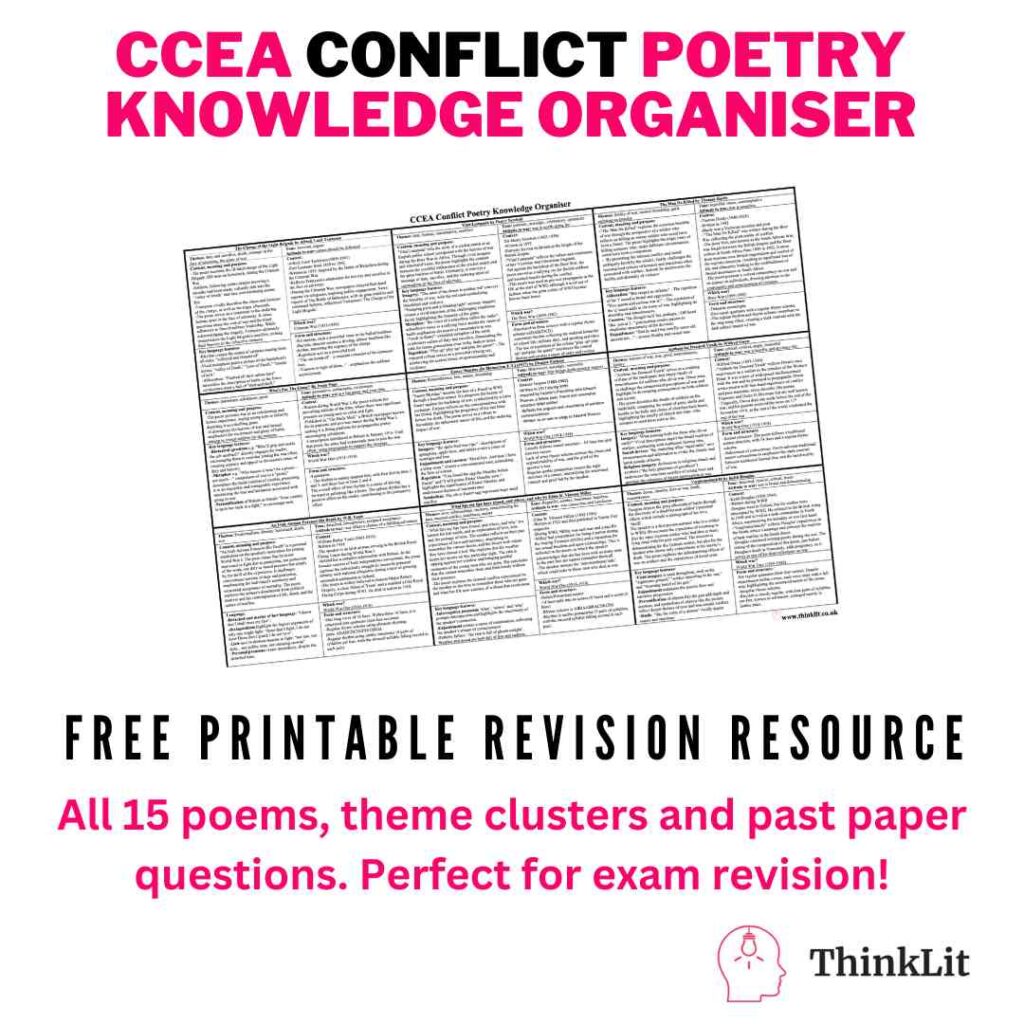
Free Conflict Poetry Knowledge Organiser
Sign up to ThinkLit's mailing list to get your free CCEA Conflict Poetry Knowledge Organiser
Thank you!
You have successfully joined our subscriber list.
Download your free printable knowledge organiser by clicking this link.
